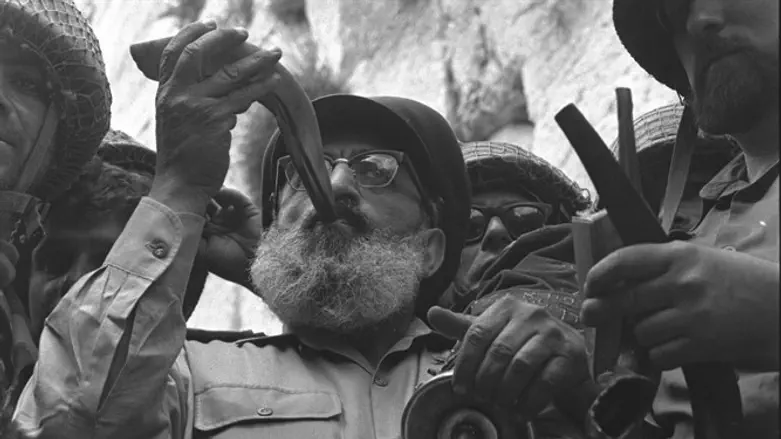
Only once in the last thousand years (since the second Muslim conquest of the Holy Land - the first was in the 7th century after the rise of Islam) has a Yom Kippur service been carried out on the Temple Mount. Kept secret for nearly 50 years, the prayer leader at the time recently told the story to correspondent Haggai Huberman.
The service was complete with prostrations as in Temple times, though without sacrificial and incense offerings. The main participant was none other than Rabbi Menachem HaCohen (the name Cohen means priest and almost always denotes someone descended from Moses' brother Aaron, the first Priest), who served in the past as Labor Party Knesset Member, Rabbi of the national Histadrut Labor Organization, and top aide to IDF Chief Rabbi Maj.-Gen. Shlomo Goren. In the famous photo of Rabbi Goren blowing the shofar atop the Mount upon its 1967 liberation by Israeli forces, Rabbi HaCohen can be seen at his side.
After the Six Day War, a sharp dispute arose between Defense Minister Moshe Dayan, who “returned the Temple Mount keys” to the Waqf, and Rabbi Goren, who felt that Jews must be allowed to pray at their most sacred site and wanted to build a synagogue there. After Rabbi Goren held a Tisha B’Av prayer service atop the Mount just six weeks after the Six Day War, Dayan forbade him by military order to pray there again.
For Yom Kippur, just two months later, Rabbi Goren had an inspiration. On the morning of Yom Kippur eve, he appeared at Rabbi HaCohen’s home in Ramat Gan with ten IDF Rabbinate soldiers, and told him, “Dayan has forbidden me to hold a prayer service on the Mount, but he said nothing about you. Here are ten soldiers, and a Torah scroll – I ask you to please take my place and make a minyan [prayer service] there.”
Huberman reports that Dayan knew of Rabbi Goren’s plan, but did not stop it. He feared that a minyan run by the Chief Rabbi, with the rank of Maj.-Gen. [today, IDF Chief Rabbis are not ranked as high] would cause an international uproar.
Rabbi HaCohen told Huberman that he was very excited to fulfill the request, and even took his two sons, aged 8 and 5, along with him. Rabbi HaCohen’s father Mordechai authored scholarly books proving the existence of a synagogue on the Temple Mount during the Middle Ages, as well as Maimonides’ visit to the holy site.
Rabbi HaCohen led most of the prayer services, and the highlight was when he reached the phrase recited by the High Priest on Yom Kippur [in free translation]: “Please, G-d, I have sinned, as have the other Priests [and the Nation]. Please, atone for our sins, as is written in Your Torah: ‘On this day G-d will atone for you and purify you of your sins.’” The High Priest would then recite the Ineffable Name of G-d, at which point the entire congregation would bow down and fall on their faces – which is precisely what the participants in the modern-era service of 1967 did, just meters away from where the service was held for hundreds of years in purity and holiness.
The worshipers did not leave the Border Guard position near the Al Aqsa mosque the entire day, by order of Rabbi Goren. Only 8-year-old Meron managed to sneak out and actually stood at the entrance to the mosque.
Following the final prayer service, as Yom Kippur ebbed away, the worshipers went out and stood in the middle of the plaza, where Rabbi HaCohen actually blew the shofar signaling the end of the holy day. “As I blew the shofar,” he recalled, “I could hear the shofar being blown below us, at the Western Wall plaza.”
The return of the Yom Kippur service once again to the Temple Mount may appear far off at present, but the Jewish People continue to pray every day: “Restore the service to Your holy house… May our eyes see Your return to Zion.”